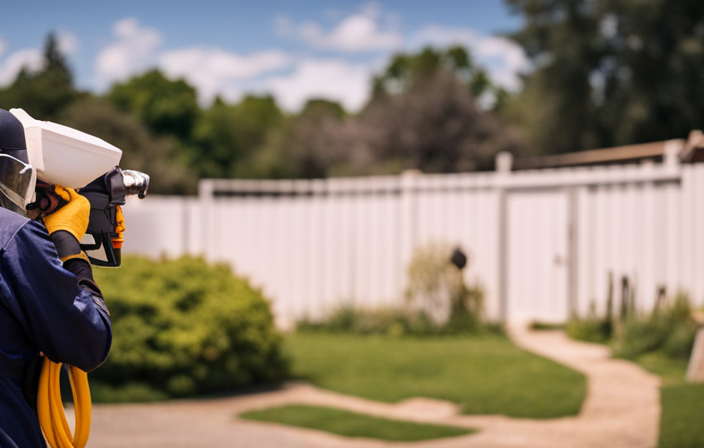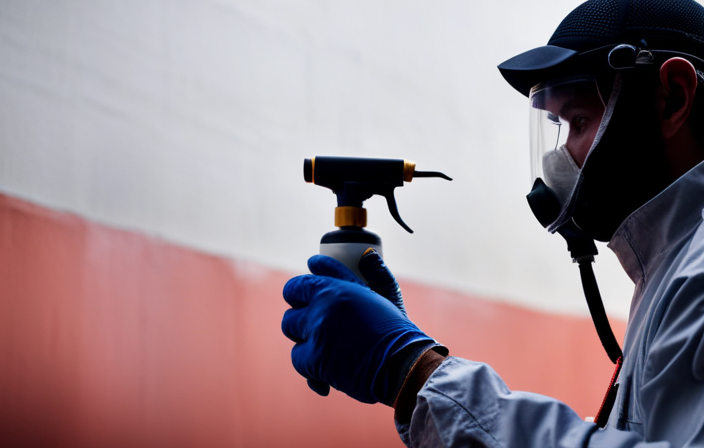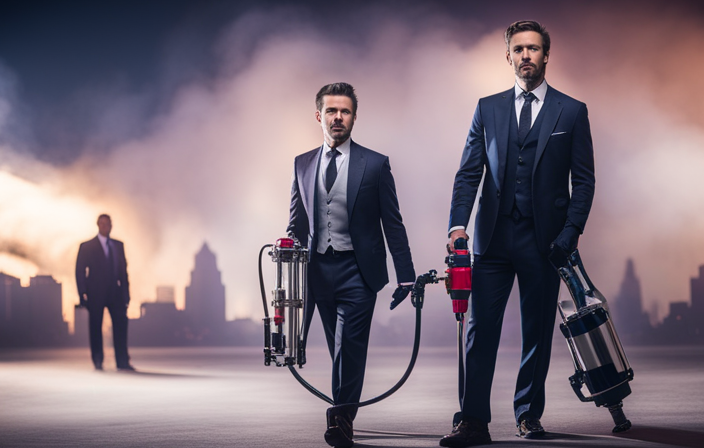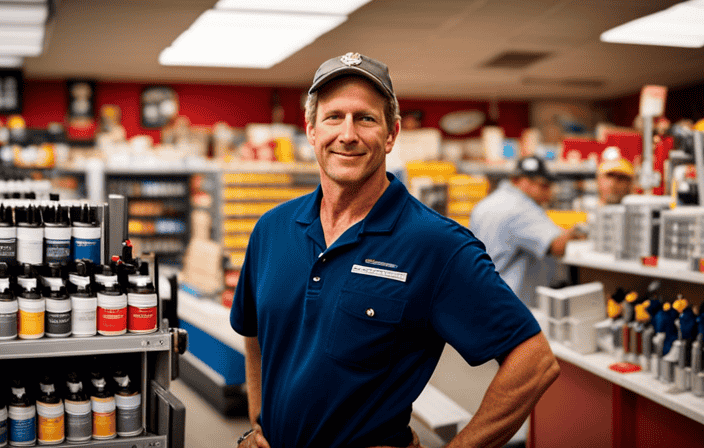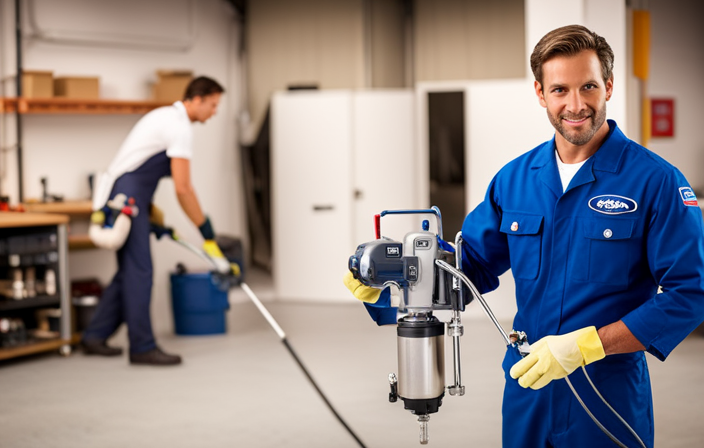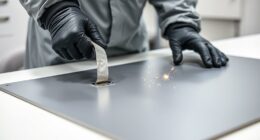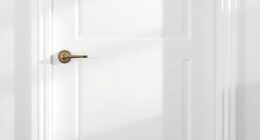Painting the exterior of your house may seem overwhelming at first, but with the proper tools and techniques, it can become a fun task. In this blog post, I am thrilled to share my knowledge and tips on using an airless paint sprayer for your outdoor painting projects.
Think of the airless paint sprayer as your trusty sidekick, effortlessly delivering a smooth and even coat of paint to every nook and cranny of your home’s exterior. With its precision and power, this tool will save you time and effort, ensuring a professional-looking finish that will make your home the envy of the neighborhood.
In this article, I will guide you through the process, from choosing the right equipment to maintaining the sprayer, so you can achieve outstanding results and transform your home’s appearance.
So let’s jump right in and unlock the secrets to mastering the airless paint sprayer for your exterior painting needs.
Key Takeaways
- Apply multiple coats if needed to achieve optimal results
- Clean and maintain the sprayer regularly for proper functioning
- Store the sprayer in a clean and dry area to prevent damage
- Refer to the user manual and troubleshoot any issues promptly for optimal performance.
Choose the Right Paint and Equipment
Before diving into the world of airless paint sprayers for your exterior painting project, let’s talk about how to choose the right paint and equipment for the job.
When selecting paint color, it’s important to consider the overall aesthetic of your home and the surrounding environment. Opt for colors that complement the existing features and blend harmoniously with the neighborhood.
Additionally, proper safety precautions should be taken into account. Make sure to wear protective clothing, goggles, and a respirator to shield yourself from harmful fumes and particles.
As for equipment, invest in a high-quality airless paint sprayer that suits your specific needs. Look for one that offers adjustable pressure settings and a wide range of spraying patterns.
Now that we have the paint and equipment covered, let’s move on to preparing the surface for a flawless finish.
Prepare the Surface
To ensure a smooth and long-lasting finish, it’s important to properly prime and clean the surface beforehand, allowing the paint to adhere effectively. Surface preparation is crucial in achieving professional results with an airless paint sprayer for exterior projects. Start by thoroughly cleaning the surface to remove any dirt, dust, or debris. Use a mild detergent and water, or a pressure washer if necessary. Next, inspect the surface for any cracks, holes, or peeling paint, and repair or patch them as needed. After the surface is clean and repaired, apply a primer to create a smooth and even base for the paint. The primer will help the paint adhere better and improve its durability. Once the primer has dried, you’re ready to move on to the next step of protecting the surrounding areas while painting.
Protect Surrounding Areas
Make sure you shield the surrounding areas to prevent any accidental splatters or drips from ruining nearby surfaces.
Start by covering any furniture or objects that you don’t want to get paint on. Use plastic drop cloths or old sheets to protect the ground and any plants or landscaping.
Next, secure the edges of the drop cloths or sheets with masking tape to ensure they stay in place during the painting process. Pay close attention to corners and crevices, as these areas are more prone to leaks or overspray.
By taking the time to properly protect the surrounding areas, you’ll save yourself from having to clean up a mess later on.
Now that everything is covered and protected, it’s time to practice proper technique when using the airless paint sprayer.
Practice Proper Technique
Once you’ve shielded the surrounding areas, it’s time to get hands-on and master the art of flawlessly painting with an airless paint sprayer.
Proper hand positioning is crucial to achieve smooth and even coverage. Start by gripping the sprayer firmly with one hand on the handle and the other on the trigger. Keep your wrists straight and maintain a comfortable distance from the surface. This will give you better control over the sprayer’s movement and prevent hand fatigue.
Additionally, controlling overspray is key to a professional finish. To minimize overspray, adjust the pressure settings on the sprayer and move in a steady, even motion.
Finally, to ensure the sprayer is working properly and the paint is the desired consistency, start with a test area before proceeding to larger sections. This will help you make any necessary adjustments and ensure a flawless paint job.
Start with a Test Area
Before diving into the full painting process, it’s crucial to start with a small test area to ensure a flawless and professional finish. This step allows you to try different paints and troubleshoot common issues that may arise.
Here are four important things to keep in mind during this test phase:
-
Choose a representative area: Select a portion of the surface that exhibits the same conditions as the rest of the project, such as texture and color.
-
Adjust the spray settings: Experiment with the airless paint sprayer’s pressure and fan width to achieve the desired coverage and atomization.
-
Test different paints: Apply a small amount of each paint you plan to use on the test area to evaluate their compatibility and appearance.
-
Address any issues: If you encounter problems like clogging or uneven coverage, troubleshoot and make necessary adjustments before proceeding.
By starting with a test area, you can refine your technique and address any potential issues before tackling the entire project. This ensures a smooth transition as you move on to applying the paint in even strokes.
Apply the Paint in Even Strokes
Achieve a flawless and professional finish by applying the paint in smooth and even strokes, ensuring a seamless transformation of your project. Proper brush technique is essential to achieving a smooth finish with an airless paint sprayer. To ensure even coverage, hold the sprayer about 12 inches away from the surface and move it in a steady back-and-forth motion. Avoid stopping or hesitating in one area, as this can result in uneven application. A helpful tip is to imagine painting with a wide brush, using the sprayer to mimic the strokes of a brush. By maintaining a consistent distance and speed, you can achieve a smooth and professional-looking paint job. Once you have mastered the technique, you can proceed to the next step of working in small sections for better control and coverage.
Work in Small Sections
After applying the paint in even strokes, it’s important to work in small sections to achieve a smooth finish when using an airless paint sprayer for exterior projects. This technique allows you to focus on one area at a time, ensuring that the paint is evenly distributed and avoiding any streaks or inconsistencies.
By dividing the surface into manageable sections, you can maintain better control over the application process. Additionally, working in small sections allows you to troubleshoot any common issues that may arise, such as clogging or overspray. If you encounter any problems, you can quickly address them without affecting the entire project.
This method also helps in maintaining a consistent distance from the surface, which we will discuss in the subsequent section.
Maintain a Consistent Distance
To ensure a flawless finish, it’s crucial to keep a constant and careful distance while applying the paint with an airless sprayer. By maintaining a steady hand and controlling overspray, you can achieve professional results. To help you visualize the importance of distance, consider the following table:
| Distance | Result |
|---|---|
| Too close | Uneven coverage, drips |
| Just right | Smooth, even coat |
| Too far | Thin, patchy finish |
By maintaining a consistent distance, you can avoid drips and ensure that the paint is applied evenly. This will prevent any potential rework or touch-ups. Additionally, it allows the paint to dry evenly, resulting in a more durable and long-lasting finish. Once you have mastered maintaining the right distance, you can confidently move on to applying multiple coats if needed. This will further enhance the appearance and durability of your paint job.
Apply Multiple Coats if Needed
After ensuring a consistent distance during the painting process, it’s important to assess the coverage and drying time of the initial coat.
Depending on the type of surface and the desired finish, it may be necessary to apply multiple coats for optimal results. This will ensure even coverage and a smooth, professional-looking finish.
When applying multiple coats, it’s crucial to allow sufficient drying time between each layer. This will prevent smudging or the paint from becoming tacky.
It’s also important to keep an eye out for any common issues that may arise, such as clogging or uneven spray patterns. Troubleshooting these problems promptly will help maintain the efficiency and effectiveness of the airless paint sprayer.
Next, let’s discuss ideas on how to clean and maintain the sprayer to ensure its longevity and continued performance.
Clean and Maintain the Sprayer
Keeping the sprayer clean and well-maintained is crucial for ensuring its longevity and optimal performance. Proper storage is key to preventing clogs and damage. After each use, thoroughly clean the sprayer by flushing it with water or a cleaning solution recommended by the manufacturer. Pay attention to the nozzle, filter, and other components, removing any paint residue or debris. Store the sprayer in a clean and dry area, away from extreme temperatures.
To troubleshoot common issues, refer to the user manual for specific instructions. If the sprayer is not spraying evenly, check for clogs or worn parts and clean or replace them accordingly. If the sprayer is leaking, tighten the connections or replace worn seals. Regularly inspect the sprayer for any signs of damage or wear and address them promptly. By following these maintenance steps, you can ensure the airless paint sprayer continues to work effectively and efficiently.
| PROPER STORAGE | TROUBLESHOOT COMMON ISSUES |
|---|---|
| Store in clean, dry area | Check for clogs |
| Keep away from extremes | Replace worn parts |
| of temperature | Tighten connections |
Frequently Asked Questions
How do I choose the right paint color for my exterior project?
When choosing paint colors for an exterior project, consider the overall style of your home, the neighborhood, and any existing features. Take into account the lighting conditions and test paint samples on different areas before making a final decision.
Can I use an airless paint sprayer on all types of surfaces?
Yes, an airless paint sprayer can be used on a variety of surfaces. However, when using it on delicate surfaces, it’s important to take precautions to avoid damage. Here are some tips for achieving a smooth finish with an airless paint sprayer.
Are there any safety precautions I should take while using an airless paint sprayer?
When using an airless paint sprayer, it’s crucial to take safety precautions. According to a study, 40% of accidents involving paint sprayers occur due to improper use. To ensure safety, wear protective gear, ventilate the area, and follow proper operating procedures.
How do I prevent clogging or inconsistent spraying when using an airless paint sprayer?
To prevent clogging or inconsistent spraying with an airless paint sprayer, I recommend cleaning the nozzle regularly, using the correct paint viscosity, and ensuring proper pressure settings. Adjusting the spray pattern and distance can also help prevent overspray.
How long should I wait before applying a second coat of paint with an airless paint sprayer?
To achieve a smooth finish with an airless paint sprayer, it is important to wait for the first coat to dry completely before applying a second coat. Additionally, properly cleaning the sprayer after each use is essential for optimal performance.
Conclusion
In conclusion, using an airless paint sprayer for exterior projects can be a game-changer. The efficiency and speed it offers are unmatched, allowing you to complete your painting tasks in no time.
However, it’s crucial to choose the right paint and equipment, prepare the surface properly, and protect surrounding areas.
By practicing proper technique, starting with a test area, and working in small sections, you can achieve a flawless finish. Remember to maintain a consistent distance and apply multiple coats if needed.
Lastly, don’t forget to clean and maintain the sprayer for optimal performance.
So, grab your airless paint sprayer and transform your exterior spaces with ease and precision.
